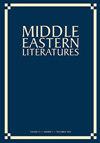“Pantomime”: A short story by Sami Paşazade Sezai
IF 0.2
4区 文学
0 LITERATURE
引用次数: 0
Abstract
“Pantomime” ( پ ا ن د و م ی م ا , 1891 ) by nineteenth-century Ottoman writer Sami Paşazade Sezai (1859–1936) is considered by critics as one of the first modern short stories in Turkish literature, and a precursor of Turkish literary realism. As suggested by the title of the collection in which it was published, Little Things ( ك و چ ك ش ي ل ر Küçük Şeyler), Sezai’s aspiration was to make the unnoticed appear, telling the story of the seemingly ordinary details of everyday life. A transitional writer who comfortably navigated the familiar waters of Romanticism while experimenting with Realism, Sezai crafted his stories with the awareness that he was writing at the crossroads of language reform and literary explorations in the fin de siècle Ottoman Empire. Although he admired French writers like most of his contemporaries (he even translated Daudet’s “L’Arlésienne” in Little Things), he developed a distinct authorial voice through his engagement with form and language in his short stories. In this sense, “Pantomime” constitutes a canonical story in Ottoman literature that represents Sezai’s literary style and it demonstrates the liminality of writing practices at the time, between tradition and modernity, Romanticism and Realism. “Pantomime” is about the tragic life and suicide of a thirty-three-year-old clown, Pascal. The most distinct element in the story is the ubiquitous silence that pervades Pascal’s life, blurring the line between his pantomime presence on stage, and his existence offstage. The writer masterfully distills the unsettling silence in the plot and contrasts it with the laughter of the spectators and the jovial twitter of birds. One of the story’s most recurring words, س ک و ن ت (sükûnet: quietude, stillness), also testifies to the uneasy stillness that the writer weaves into the story. This intense sadness ( ح ز ن , hüzün) also spills into the city. Even the ruins of the Byzantine fortress and chant-like bird songs exude melancholy. While the author’s melancholic gaze paints every part of Istanbul with hüzün, it is Pascal’s tragic life that remains central to the story. For Sezai, it is the tragic life of an outsider that lends itself to literary exploration. His contemplative storytelling negotiates descriptions of Pascal, who is portrayed as both a circus performer and a human, and as both comedic and tragic. While Romanticism is heavily felt in Sezai’s depictions of Byzantine ruins, gardens, and the big tree in the courtyard of Pascal’s house, keen physical and psychological depictions of him demonstrate modern elements. Most interesting, and most challenging to capture in translation, is the quiet yet intense storytelling in “Pantomime.” Also hard to render is Sezai’s economy of words which depart from the style of earlier short stories. His language is lighter and his paragraphs are not drowned by long and ornate Persian ezāfe ( ا ض ا ف ه : Persian grammatical construct where words are annexed to make adjectival phrases, also used in naming and denoting possession). His sentences, although long and at times syntactically-《哑剧》:萨米·帕鲁扎德·塞扎伊的短篇小说
“哑剧”(پاندومیما,1891)19世纪奥斯曼作家萨米Paşazade Sezai(1859 - 1936)被评论家认为是第一个现代短篇小说在土耳其文学,和一个土耳其文学现实主义的先驱。正如出版的作品集的标题所暗示的那样,小事情(k Şeyler), Sezai的愿望是让不被注意的事情出现,讲述日常生活中看似平凡的细节。塞扎伊是一位过渡时期的作家,他在熟悉的浪漫主义水域中游弋自如,同时尝试现实主义。塞扎伊在创作自己的故事时,意识到自己正处于奥斯曼帝国末期语言改革和文学探索的十字路口。尽管他像大多数同时代的法国作家一样崇拜法国作家(他甚至在《小事》中翻译了多代的《阿尔萨西恩》),但他通过在短篇小说中对形式和语言的关注,形成了一种独特的作家声音。从这个意义上说,《哑剧》构成了奥斯曼文学中的一个典型故事,代表了塞扎伊的文学风格,它展示了当时写作实践的局限性,介于传统与现代、浪漫主义与现实主义之间。《哑剧》讲述了33岁的小丑帕斯卡的悲惨生活和自杀。故事中最明显的元素是弥漫在帕斯卡生活中的无处不在的沉默,模糊了他在舞台上的哑剧表演和他在舞台下的存在之间的界限。作者巧妙地提炼出情节中令人不安的沉默,并与观众的笑声和鸟儿欢快的鸣叫形成对比。这个故事中最常出现的词汇之一,(s k网:安静,静止),也证明了作者在故事中编织的令人不安的静止。这种强烈的悲伤也蔓延到城市里。即使是拜占庭堡垒的废墟和像圣歌一样的鸟鸣也散发着忧郁的气息。虽然作者忧郁的目光用h z n描绘了伊斯坦布尔的每一个角落,但帕斯卡的悲惨生活仍然是故事的核心。对于Sezai来说,这是一个局外人的悲惨生活,适合文学探索。他对帕斯卡的描述是深思熟虑的,他被描绘成一个马戏团演员和一个人,既是喜剧又是悲剧。虽然塞扎伊对拜占庭废墟、花园和帕斯卡家院子里的大树的描绘充满了浪漫主义色彩,但他对帕斯卡的身体和心理的敏锐描绘展示了现代元素。在翻译中,最有趣也是最具挑战性的是《哑剧》中安静而激烈的故事叙述。同样难以描绘的是,世宰的措辞与早期短篇小说的风格大相径庭。他的语言比较轻松,段落也没有被冗长华丽的波斯语所淹没ezāfe(:波斯语的语法结构,把单词加在一起构成形容词短语,也用于命名和表示财产)。他的句子虽然很长,而且有时句法上很混乱
本文章由计算机程序翻译,如有差异,请以英文原文为准。
求助全文
约1分钟内获得全文
求助全文

 求助内容:
求助内容: 应助结果提醒方式:
应助结果提醒方式:


